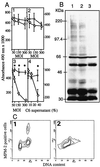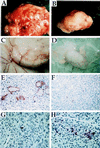Angiostatin gene transfer: inhibition of tumor growth in vivo by blockage of endothelial cell proliferation associated with a mitosis arrest
- PMID: 9600971
- PMCID: PMC27714
- DOI: 10.1073/pnas.95.11.6367
Angiostatin gene transfer: inhibition of tumor growth in vivo by blockage of endothelial cell proliferation associated with a mitosis arrest
Abstract
The antitumoral effects that follow the local delivery of the N-terminal fragment of human plasminogen (angiostatin K3) have been studied in two xenograft murine models. Angiostatin delivery was achieved by a defective adenovirus expressing a secretable angiostatin K3 molecule from the cytomegalovirus promoter (AdK3). In in vitro studies, AdK3 selectively inhibited endothelial cell proliferation and disrupted the G2/M transition induced by M-phase-promoting factors. AdK3-infected endothelial cells showed a marked mitosis arrest that correlated with the down-regulation of the M-phase phosphoproteins. A single intratumoral injection of AdK3 into preestablished rat C6 glioma or human MDA-MB-231 breast carcinoma grown in athymic mice was followed by a significant arrest of tumor growth, which was associated with a suppression of neovascularization within and at the vicinity of the tumors. AdK3 therapy also induced a 10-fold increase in apoptotic tumor cells as compared with a control adenovirus. Furthermore, we showed that systemic injection of AdK3 delayed C6 tumor establishment and growth, confirming that angiostatin can function in a paracrin manner. Our data support the concept that targeted antiangiogenesis, using adenovirus-mediated gene transfer, represents a promising alternative strategy for delivering antiangiogenic factors as their bolus injections present unsolved pharmacological problems.
Figures





Similar articles
-
Combined effects of radiotherapy and angiostatin gene therapy in glioma tumor model.Proc Natl Acad Sci U S A. 2000 Jun 6;97(12):6698-703. doi: 10.1073/pnas.110134297. Proc Natl Acad Sci U S A. 2000. PMID: 10823901 Free PMC article.
-
Systemic administration of a recombinant adenovirus encoding a HSA-Angiostatin kringle 1-3 conjugate inhibits MDA-MB-231 tumor growth and metastasis in a transgenic model of spontaneous eye cancer.Mol Ther. 2003 Feb;7(2):174-84. doi: 10.1016/s1525-0016(02)00057-6. Mol Ther. 2003. PMID: 12597905
-
High level of stabilized angiostatin mediated by adenovirus delivery does not impair the growth of human neuroblastoma xenografts.Cancer Gene Ther. 2003 Nov;10(11):859-66. doi: 10.1038/sj.cgt.7700639. Cancer Gene Ther. 2003. PMID: 14605672
-
Angiostatin: an endogenous inhibitor of angiogenesis and of tumor growth.EXS. 1997;79:273-94. EXS. 1997. PMID: 9002223 Review.
-
Inhibition of tumor angiogenesis by angiostatin: from recombinant protein to gene therapy.Endothelium. 2002;9(1):3-10. doi: 10.1080/10623320210712. Endothelium. 2002. PMID: 12901356 Review.
Cited by
-
Non-cytotoxic therapies for malignant gliomas.J Neurooncol. 2002 May;58(1):57-69. doi: 10.1023/a:1015839111005. J Neurooncol. 2002. PMID: 12160142 Review.
-
Mechanism and its regulation of tumor-induced angiogenesis.World J Gastroenterol. 2003 Jun;9(6):1144-55. doi: 10.3748/wjg.v9.i6.1144. World J Gastroenterol. 2003. PMID: 12800214 Free PMC article. Review.
-
Recombinant, replication-defective adenovirus gene transfer vectors induce cell cycle dysregulation and inappropriate expression of cyclin proteins.J Virol. 1998 Dec;72(12):9491-502. doi: 10.1128/JVI.72.12.9491-9502.1998. J Virol. 1998. PMID: 9811682 Free PMC article.
-
Angiostatin inhibits endothelial and melanoma cellular invasion by blocking matrix-enhanced plasminogen activation.Biochem J. 1999 May 15;340 ( Pt 1)(Pt 1):77-84. Biochem J. 1999. PMID: 10229661 Free PMC article.
-
Adeno-associated virus type-2 expression of pigmented epithelium-derived factor or Kringles 1-3 of angiostatin reduce retinal neovascularization.Proc Natl Acad Sci U S A. 2002 Jun 25;99(13):8909-14. doi: 10.1073/pnas.122247299. Epub 2002 Jun 18. Proc Natl Acad Sci U S A. 2002. PMID: 12072560 Free PMC article.
References
Publication types
MeSH terms
Substances
LinkOut - more resources
Full Text Sources
Other Literature Sources
Miscellaneous

